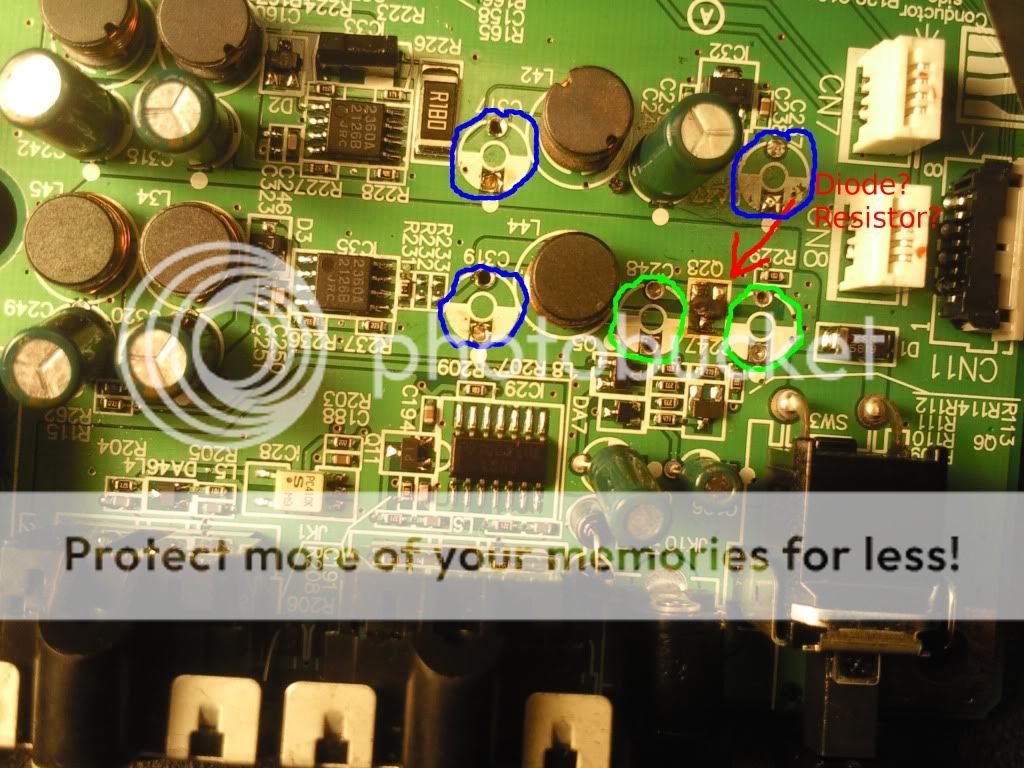Hey everyone! New to the board, hopefully I'm posting this in the right place! 🙂
I'm attempting to repair a Roland SPD-S, and with no help from Roland, I'm left to figure out what this burnt SMT component is.
In the picture:
The RED arrow is pointing to what? A diode, resistor?
The BLUE circles are empty resistor spots, is this typical to see from a manufacturer? The GREEN circles are just to signify the resistors I removed to make it easier to work on the SMT in question.
Any and all feedback is greatly appreciated! 🙂

I'm attempting to repair a Roland SPD-S, and with no help from Roland, I'm left to figure out what this burnt SMT component is.
In the picture:
The RED arrow is pointing to what? A diode, resistor?
The BLUE circles are empty resistor spots, is this typical to see from a manufacturer? The GREEN circles are just to signify the resistors I removed to make it easier to work on the SMT in question.
Any and all feedback is greatly appreciated! 🙂

The C in C319 and C317 means it is a Capacitor , The Q in Q23 means it is a Transistor not a Diode , a diode would be designated with a D .....
So it looks like you need 5 electrolytic caps of an unknown Value and a transistor of an unknown type ......
Good luck
So it looks like you need 5 electrolytic caps of an unknown Value and a transistor of an unknown type ......
Good luck
Thanks for the reply Minion! Yeah, my bad, I meant capacitor on those... I know which type those are, but they seem very clean, like they weren't touched, I'm not sure if they were purposely left out of the manufacturing process or not. Is there anyway to find the value of the transistor? Or is it possible it is still fuctioning?
When in doubt, use a 2n2222. Unsolder it (yeah, not easy, use heat blower gun) and see if the two diodes from the base to col and emi still forward bias and negative block. That will also tell you if it is npn (2n2222) or pnp. If so, that is not the problem. You could also bet that the collector end is connected to something bigger like a transistor with a heat sink. Pick up a copy of "Electronic Devices, Electron Flow Version" by Floyd, Prentice Hall, at the community college bookstore or, like me, at Goodwill for $2. Very useful for basic troubleshooting techniques. I knew tubes, and basic BJT's, but they have invented a lot of stuff since I went to college. The books I had before from 1970 also had a lot of stupid calculation theory that nobody ever does. The formulas in this book are a lot more useful.
Last edited:
So I received my caps from Digikey, soldered them all in, powered up the unit, and saw the transistor smoking immediately... What causes this? Bad transistor or something else?
it's quite common to have unpopulated components such as those two caps on a PC board. manufacturers may make several similar models of something with various features or options. it's more cost effective to make circuit boards that can be used in several similar models and just populate the parts that are needed for a particular model and bypass the unused portion with jumpers. for instance XYZ Corp makes a series of amplifiers called their 300 series. the 301 is 100W, 302 is 200W and 305 is 500W. the 301 has a single pair of output transistors, the 302 has two pair of output transistors and the 305 uses five pair of output transistors. all 3 amplifiers use the same circuit board, but different power transformers, and other power components. the 100W circuit board has the basic amplifier and the circuitry for one pair of output devices populated, leaving the rest of the board unpopulated. the 200W version has more parts on it, and the 500W board has all of the components on it.
your transistor smoked again because something else in the circuit is also shorted.
your transistor smoked again because something else in the circuit is also shorted.
- Status
- Not open for further replies.
- Home
- Design & Build
- Parts
- Which PCB Component?